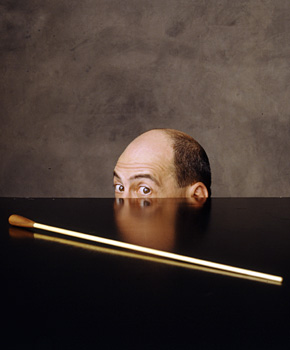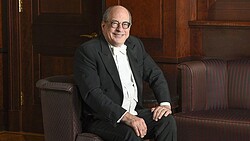After 20 years as music director of the Atlanta Symphony Orchestra, conductor Robert Spano recently moved to the Dallas-Fort Worth Metroplex from Atlanta when he became the newly appointed music director of the Fort Worth Symphony Orchestra. Founded in 1912 but temporarily disbanded during both world wars, FWSO is an orchestra with a long and distinguished history.
The orchestra’s first concerts were presented in less-than-ideal venues, starting out in the barn-like Will Rogers Auditorium. They moved to the only slightly better Fort Worth Convention Center in 1968. But, it wasn’t until the 1998–1999 season that the symphony finally moved into a world-class venue, Bass Performance Hall, and there they remain to this day, except for a temporary displacement during the COVID-19 pandemic where they again gave concerts at Will Rogers Auditorium.
In 2019, Spano first appeared with the orchestra as a guest conductor. His appearance was so successful that the orchestra grabbed onto him. Soon after, Spano was named principal guest conductor. Then, in 2022, he ascended to the musical directorship, replacing the retiring Miguel Harth-Bedoya, who held the position for 20 years.
Music is Spano’s birthright. His father was a clarinetist, a flute designer, and an instrument repair technician. Early on, he naturally studied the flute, as well as violin, and piano. He earned a degree in piano performance at the highly respected Oberlin College and Conservatory. After that, he attended the equally respected Curtis Conservatory of Music, studying with Max Rudolf, an internationally lauded conductor and conducting teacher. Spano has retained an official relationship with Curtis to this day.
In addition to his conducting career, Spano is also known as a pianist and composer. Frequently, he combines these two abilities by playing his own works. I asked him if he was ever unhappy when hearing a recording of such a performance. The ever-practical Spano replied, “Not really, but other performers can bring different insights that are very valuable.”
Robert Spano, music director of the Fort Worth Symphony Orchestra. (credit: Karen Almond)
Robert Spano, music director of the Fort Worth Symphony Orchestra. (credit: Karen Almond)
Robert Spano in Fort Worth: catching up with the Maestro, thoughts on conducting
Gregory Sullivan Isaacs | 15 DEC 2023
After 20 years as music director of the Atlanta Symphony Orchestra, conductor Robert Spano recently moved to the Dallas-Fort Worth Metroplex from Atlanta when he became the newly appointed music director of the Fort Worth Symphony Orchestra. Founded in 1912 but temporarily disbanded during both world wars, FWSO is an orchestra with a long and distinguished history.
The orchestra’s first concerts were presented in less-than-ideal venues, starting out in the barn-like Will Rogers Auditorium. They moved to the only slightly better Fort Worth Convention Center in 1968. But, it wasn’t until the 1998–1999 season that the symphony finally moved into a world-class venue, Bass Performance Hall, and there they remain to this day, except for a temporary displacement during the COVID-19 pandemic where they again gave concerts at Will Rogers Auditorium.
In 2019, Spano first appeared with the orchestra as a guest conductor. His appearance was so successful that the orchestra grabbed onto him. Soon after, Spano was named principal guest conductor. Then, in 2022, he ascended to the musical directorship, replacing the retiring Miguel Harth-Bedoya, who held the position for 20 years.
Music is Spano’s birthright. His father was a clarinetist, a flute designer, and an instrument repair technician. Early on, he naturally studied the flute, as well as violin, and piano. He earned a degree in piano performance at the highly respected Oberlin College and Conservatory. After that, he attended the equally respected Curtis Conservatory of Music, studying with Max Rudolf, an internationally lauded conductor and conducting teacher. Spano has retained an official relationship with Curtis to this day.
In addition to his conducting career, Spano is also known as a pianist and composer. Frequently, he combines these two abilities by playing his own works. I asked him if he was ever unhappy when hearing a recording of such a performance. The ever-practical Spano replied, “Not really, but other performers can bring different insights that are very valuable.”
Advertisement
AD ASO.2023.EarR.600x250.SoundsSeason
AD KSU Band of Other Brothers
In the future, Spano said that he has some significant appearances on the horizon but that he can’t talk about them at the moment. But he will certainly continue his successful stint in Fort Worth and spend his summers teaching at the Aspen Festival.
On January 4, Spano will partner with the FWSO and the Dallas Black Dance Theater in a staging of Stravinsky’s neo-classical ballet, Petrushka, as choreographed by Sean Smith. Also on that program are two masterworks by Mozart. One is his Overture to the Opera The Magic Flute paired with his final, perhaps greatest, and longest symphony, Symphony No. 41 (“Jupiter”).
But Spano will return to Atlanta in May for two weeks of concerts with the Atlanta Symphony Orchestra as its conductor laureate. First, to conduct the marvelous pianist Garrick Ohlsson in a performance of Rachmaninoff’s deservedly popular Piano Concerto #3, paired with the world premiere of Concerto for Orchestra by Emmy Award-winning composer Adam Schoenberg (May 9-11). The following week, Spano will lead the ASO in another world premiere, The Sacrifice of Isaac by Jonathan Leshnoff, and Stravinsky’s The Rite of Spring.
As you would expect, our conversation eventually turned to conducting and the current assessment of various podium techniques.
I mentioned that, recently, more and more conductors have been eschewing the use of the baton. Spano said: “I am comfortable using a baton, in most cases, but sometimes I dispense with it when conducting some big works, such as Bach’s various settings of the Passion.” Of course, in Bach’s time, no one actually conducted as we know it today. Usually, it was the composer at some keyboard who filled that function.
Also, I mentioned that there are as many ideas about conductor’s gestures as there are conductors. Spano offered the following observations.
“Gestures have to be meaningful and convey the music to the performers. Period. There are five categories of gestures, as they relate to both hands: parallel (mirroring) which is different from similar. The others are contrary, counterpoint, and oblique. Each has its own purpose. Mostly, this applies to the use of the left hand, which should offer supplemental information.”
He added with a smile in his voice: “…we tell ourselves ‘don’t mirror’, but then it happens anyway. But it is the results a conductor gets, what happens in the actual performance, that matters. I find that one of the best ways to evaluate a conductor’s performance is to close your eyes (and just listen). When I teach conducting at Aspen (an internationally recognized summer music festival), it is surprising to hear how different the orchestra sounds with each of the student conductors.”
Then I mentioned one universal conundrum with orchestras is how to place the five divisions of string section: first violins, second violins, violas, cellos, and contrabasses. What is the “standard” arrangement anyway? The story goes that it was established in the 1920s by the legendary Leopold Stokowski, the conductor of the Philadelphia Orchestra at the time. This is why the arrangement is sometimes referred to as the “Stokowski Shift.”
This string layout is in a semi-circle in front of the conductor with the high instruments (violins) on the conductor’s left and the lower-pitched instruments (viola, cello, bass) on the conductor’s right. The basses are almost always behind the cellos.
In past eras, some composers wrote for the violins to be split up and placed antiphonally left and right. I asked Spano about his thoughts on observing these composers’ opinions when playing works that were written for the split violin sections.
Spano said about this, “I tend to go with that standard arrangement these days. The players are used to this arrangement. I have tried other seating plans, but the cellos always sound better when they are on the outside.”
Another big controversy is how to find the “correct” tempo, (if there even is such a thing).
Spano offered that “…Tempo is the most difficult challenge any conductor faces. With some composers, such as Mozart, tempo can be determined right from the music itself. Also, Mozart is very careful with his placement of the Italian terminology (allegro, lento, etc.) When I conducted Wagner’s Der Ring des Nibelungen (a massive cycle of four operas) in Seattle, my tempi felt faster than usual but were slower when compared to the timings of other conductors.”
As to another current controversy, conducting from memory, Spano quoted the famous German conductor, Otto Klemperer, who once quipped that he always used the score “…because I can read music.” I added that the presence of the score can be a salvation if something goes wrong.
I am certain that this sort of disaster happened much more with me as a conductor than with a distinguished maestro such as Spano. ■

 Back to List
Back to List